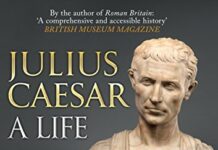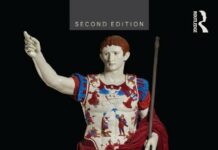
Ebook Info
- Published: 2015
- Number of pages: 520 pages
- Format: PDF
- File Size: 9.12 MB
- Authors: Patricia Southern
Description
The third century of the Roman Empire is a confused and sparsely documented period, punctuated by wars, victorious conquests and ignominious losses, and a recurring cycle of rebellions that saw several Emperors created and eliminated by the Roman armies. In AD 260 the Empire almost collapsed, and yet by the end of the third century the Roman world was brought back together and survived for another two hundred years. In this new edition of The Roman Empire from Severus to Constantine, Patricia Southern examines the anarchic era of the soldier Emperors that preceded the crisis of AD 260, and the reigns of underrated and sometimes maligned Emperors such as Gallienus, Probus and Aurelian, whose determination and hard work reunited and re-established the Empire. Their achievements laid the foundations for the absolutist, sacrosanct rule of Diocletian, honed to ruthless perfection by Constantine, whose reign transformed the pagan Empire into a Christian state. The successes and failures of the rulers of the Roman world of the third century, and the role of the armies and the civilians, are re-assessed in this revised and expanded edition of The Roman Empire from Severus to Constantine, which incorporates the latest thinking of modern scholars and has been extended to cover the reign of Constantine and the foundations he laid on which the Christian empire was built. This is a crucial volume for students of this fascinating period in Roman history, and provides invaluable background for anyone interested in the “fall of Rome”, the adoption of Christianity, and the establishment of the Byzantine Empire.
User’s Reviews
Reviews from Amazon users which were colected at the time this book was published on the website:
⭐This book gives a good overview of the “Crisis of the third century”, when the Roman Empire nearly collapsed under the combined pressures of invasion, civil war, plague, and economic depression. The Crisis began with the assassination of Emperor Severus Alexander by his own troops in 235, initiating a fifty-year period in which there were at least 26 claimants to the title of Emperor, mostly prominent Roman army generals, who assumed imperial power over all or part of the Empire.The book gives a description of these – sometimes obscure- Emperors, ending with the ascension and reforms of Diocletian in 284 and Constantine in the first half of the 4th century.What I missed in this book is a decent analysis of the economic depression; it focuses in the first place on a rather dry enumeration of the emperors / usurpers and the military. The author also makes some mistakes when she is writing about the army; e.g. “vexillatio” (a detachment of a Roman legion formed as a temporary task force) is mentioned by the author as vexillation and in plural vexillations, while the correct plural is “vexillationes”.Conclusion: Patricia Southern gives a decent survey concerning this period in Roman imperial history, but I prefer “The Roman Empire at Bay, AD 180–395” (The Routledge History of the Ancient World), 2014 by David S. Potter.
⭐good
⭐Excellent update and massive expansion of Southern’s essential book on the third century Roman world – a great read for devotees of Roman imperial history.Dr. Charles M.Odahl
⭐I have the E-book version of this book. I only have read a small part of it. It seems very promising BUT, the editing is so bad that i cannot seriously read it. I wish i could get a refund (i.e., “TH” is always spelled as “DI”, so “the” becomes “die” as if i’m reading a mixture of English and German….very bad and sad for what seems to be a very interesting book….
⭐Excellent chronicle of a very difficult time period. Unlike other histories I’ve read, this one makes it easy to follow a chaotic chronology based on limited first-hand knowledge. Great job, Ms. Southern!
⭐came fast and as described
⭐The period of history usually known as the Third Century Crisis (roughly 235 – 285) has traditionally been glossed over in classrooms and the general literature, not because it was unimportant but because there was little source material and the primary sources often gave different stories surrounding events. Yet it was a very important period when the center was not able to keep the empire together and the breakaway Gallic Empire in the West and the Palmyrene Empire in the East were for a time independent of Rome and its emperor. In addition the Northern frontiers did not hold, Dacia had to be abandoned and northern tribes took to ships to raid across the Black Sea and into the Mediterranean. The Sassanids replaced the weak Parthians in the East and raided as far as Antioch. over twenty emperors reigned in fifty years, and there were many attempts by would-be usurpers as well.British historian Pat Southern has done an excellent job at presenting this material in a book that is scholarly but nonetheless readable by the general history reading public. Over half the book is a very straightforward chronological history that covers a longer span than the Crisis itself, finding origins in the reign of Septimius Severus and following developments through the final emergence of the late empire under Constantine. She is able to do this by providing a thorough section of Notes, almost a book in itself, that explains whenever necessary, divergent opinions in both the source material and in the scholarly community. Every development is documented in this way, so if there’s a difference between the accounts of Aurelius Victor and Zosimus, you can read just what it is. Even this leaves large questions. The events in the reign of even a major emperor like Aurelian are known but not their chronological order. The section on the emperors and their reigns is followed by description and analysis of both the Northern and Eastern frontiers and the peoples with whom Rome had to contend.Pat Southern has been a Roman Military historian and as such she brings a great understanding of the actual makeup of this very important segment of Roman society, one which played a powerful role in this period. She has been one of those historians who has been part of the reassessment of Gallienus from the scapegoat of hostile senatorial sources to an important emperor who was able to keep the empire from flying apart. She avoids going into too much detail about the post-Diocletian civil wars as well as the theological controversies during Constantine’s reign, but by doing so she keeps the book focused and not of an inordinate length. There are many books to read about those subjects if you want more information.If you are curious about the period between Severus and Constantine, this is easily the most readable book.
⭐This is probably still the most accessible and affordable overview of what used to be called the “third-century crisis”. There are at least three other good books on this topic, all of which are more recent than this one. However, two of them are both massive and horribly expensive: Volume 12 of the Cambridge Ancient History set, with almost a thousand pages and the Roman Empire at Bay. In addition, the latter covers both the third and the fourth century, since it ends with the death of Theodosius I in 395. The third one is the recent volume published as part of the Edinburgh History of Ancient Rome. It is relatively short and reasonably priced, which is exactly what one might want when looking for an overview or a book to start with, but it stops in AD 284 and therefore leaves out the rather crucial reigns of Diocletian and Constantine.Apart from this, Pat Southern’s book, although published in 2001 and no longer entirely up to date – an new edition including an updated bibliography might be a good idea, by the way, especially, although not only, for students of the period – is a very good overview in many respects, and sometimes even an excellent one.An interesting feature is that it is carefully balanced. The narrative is mostly chronological but nevertheless entertaining. The author takes the trouble to lay out systematically the numerous areas of contention between historians on various issues. She also discusses these issues and the problems related to the sources while managing to avoid being boring and she also presents the most likely causes and sequences of events, in her opinion. At times, it almost feels like a textbook for university students.Even the book’s title is quite deliberate. As another reviewer mentioned, a range of other titles could have been expected. However, there are good reasons for choosing a purely chronological one. One is that the notion and scope of a “Third Century Crisis” has been disputed, as explained in the book. Another is that Pat Southern’s book is about much more than the “Soldier-Emperors” only. Rather, it is about trying to understand why the Empire changed so much, and how it both changed and survived.Contrary to what had been stated in another review, and contrary to what the book’s title imply, the story starts with the “problems” that appeared under the reign of Marcus-Aurelius (AD 161-180), followed by his son Commodus (AD 180-192), as opposed to starting straight away with Severus. It was under Marcus Aurelius that the plague first hit and weakened the Empire and that the frontiers were breached. It is also from this period onwards that the army’s importance became even more crucial than before so that it had to be supplied, paid and replenished in numbers. So the army took priority and received what it needed from a reduced pool of resources, even at the expense of the population.This grim, relentless and ruthless determination coming from a long succession of Emperors (at least those who survived more than a few months) is one of the most outstanding features that this book demonstrates. This is probably one of the reasons why the author insists on the 15 year reign of Gallienus, who is little-known and often maligned, but who managed to hold together the rump of the Empire despite terrible odds and attacks from all sides. As Pat Southern also shows very well, there was no grand plan of reforms. Changes were made on an “ad hoc” basis, in an emergency, at least up to the reign of Diocletian, and there was no time to think about potential long-term consequences. Essentially, you get the impression that The Empire was fighting for survival, and this was quite literally the case for the Emperors.Then there is the delicate issue of apportioning the changes between the various emperors, with Gallienus, Aurelian, Probus, Diocletian and Constantine being the main reformers, after Severus’ initial efforts. Here, Pat Southern is careful to avoid being categorical and stresses that the innovations or achievements of one emperor were typically amplified and reworked by his immediate successors when these had to address similar issues.This is something that is clearly shown when discussing the re-establishment of the frontiers on the Rhine. Some work was done by Probus, but also under Diocletian (or, more correctly, under Maximian and his Caesar Constantius) and then by Constantine. However, given the relatively short span of time between them (slightly more than 60 years between the accession of the first and the death of the last of them), it is very difficult to determine precisely who did what. There is a similar issue with the evolution of the army. While Gallienus did create a mobile force of cavalry, we do not hear about it after the reign of Aurelian. There is also some uncertainty as to whether this cavalry force can be equated to the Protectores or if these were only a less numerous force made up of followers and a bodyguard.Then there is also a debate regarding the respective roles and responsibilities of Diocletian and Constantine in reorganizing the defence of the frontiers and splitting up the army into frontier forces and what would become by the time of Constantine the Emperor’s field army.One of the great merits of this book is to lay out the limits of our knowledge, without pretending to know and to have the “definitive” answer, as some historians tend to do. Another significant quality is to show that change happened gradually, over time, as one emperor picked up on the empirical solutions worked out by his predecessor and amplified them because they had worked and addressed the issue immediately at hand. The last main point in favour of this book is the last three chapters of this book. The last chapter is a recap of all the changes that have been presented in chronological order in the book. The two previous ones are assessments of the Empire’s enemies to the North of the Rhine and Danube and in the East, showing how they became more dangerous and how they interacted with the weakened Empire. The price to pay for these three pieces is some amount of repetition, as the same events and reigns may be retold in a different context. This is however not excessive given the high value of this book.So, although it was published in 2001 and some more recent books have been published on the period or on some of the emperors covered (such as on Constantine, in particular), this is still probably the most accessible and most affordable overview of this very troubled period for both students and readers with a more general interest.
⭐Frankly, if I’d been in charge of naming this book I’d have called it something different: ‘The Third-Century Crisis’, or to borrow from German historiography ‘The Age of the Soldier-Emperors’. Or they could have chosen something dramatic such as ‘The Collapse of Rome’ or ‘The Survival of the Roman Empire’. They could even have used one of their own chapter names: ‘A World Geared for War.’ The current title is so painfully generic that it holds out little hope of being a readable book. Which is why it is somewhat surprising that it manages to achieve a very high level of entertainment while remaining scrupulously accurate.The book begins (unsurprisingly) with Septimius Severus. All books dealing with this time do so, which is somewhat odd since the empire didn’t change so much during his reign as after it. His main contribution was to tie the military more securely to the seat of power, thus limiting the role of senators. His successors had to deal with the increasing instability of the position of the emperor and with the ever increasing frequency of assassination. After the Severans fell, the empire passed back and forth between various generals who raised themselves to the throne only to fall within a few short years. This is what’s known as the crisis of the third-century.Towards the middle of the Third-Century Crisis the book becomes little more than a list of emperors being raised and defeated. This is the same with every book dealing with this time. Nothing can be done about it since these fluctuations are important and yet very little is known about them except for the names and a brief synopsis of their careers. This book does manage a decent summary, helped out by the inclusion of pictures for most of the emperors. There is nothing special here, but there can never be. Southern feels that Gallienus was the biggest innovator before Diocletian, having created the mobile cavalry that would form the comitatenses and promoted the careers of equestrians over those of senators. This section takes up all of the second chapter.The third chapter deals with the slow recovery from the crisis and the rise of Diocletian. After Diocletian she takes a break to look at the people surrounding the empire, ie: the barbarians and the Persians. Given the changing relationship between Rome and these powers this is an important area to cover. I’m only surprised she leaves it that long. After this comes the concluding chapter which is an analysis of what changed between the beginning of this period and its end.There’s nothing new or shocking about this book. It covers what it aims to cover in an almost entirely chronological way. I’d say that this book works best as an introduction for the beginner. Not that there isn’t valuable information in here for more advanced students, but there are other books which analyze events in more detail. Unfortunately most of these are in German. A more in-depth and thorough look at this period is
⭐The Roman Empire at Bay
⭐. It is a slightly harder read but makes it easier to figure out where to go for further reading. This book is slightly too polished to make that easy. But don’t let that deflect you from reading it. It is a very good book that is accessible to the beginner but not useless to the professional.
⭐Well written scholarly analysis of the third century Roman Empire. Fairly heavy going for the casual reader.
⭐la autora ha tratado magistralmente un tema tan difícil como el imperio romano del s. III, del que hay falta de fuentes. La información es mucha y excelentemente expuesta. Un gran libro.
⭐
Keywords
Free Download The Roman Empire from Severus to Constantine 2nd Edition in PDF format
The Roman Empire from Severus to Constantine 2nd Edition PDF Free Download
Download The Roman Empire from Severus to Constantine 2nd Edition 2015 PDF Free
The Roman Empire from Severus to Constantine 2nd Edition 2015 PDF Free Download
Download The Roman Empire from Severus to Constantine 2nd Edition PDF
Free Download Ebook The Roman Empire from Severus to Constantine 2nd Edition


